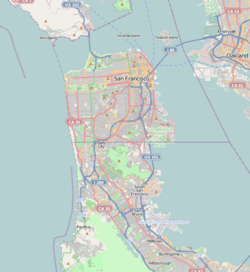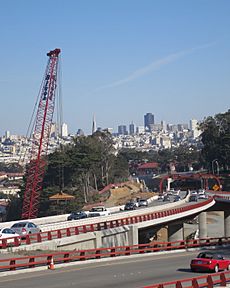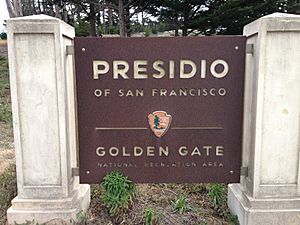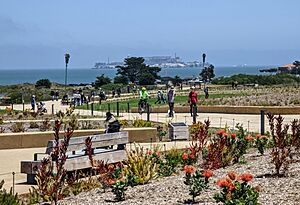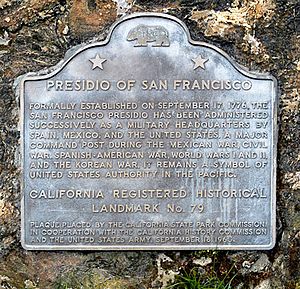Presidio of San Francisco facts for kids
Quick facts for kids
Presidio of San Francisco
|
|
|---|---|
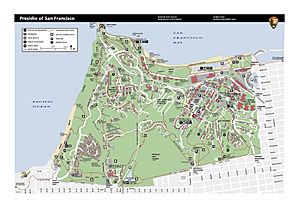
A map of the Presidio
|
|
| Country | |
| State | |
| City-county | San Francisco |
| Fortified | September 17, 1776 |
| Government | |
| • Type | Board of Supervisors |
| Area | |
| • Total | 2.4 sq mi (6 km2) |
| Population
(2019)
|
|
| • Total | 4,226 |
| • Density | 1,760/sq mi (680/km2) |
| Time zone | UTC−8 (Pacific) |
| • Summer (DST) | UTC−7 (PDT) |
| ZIP code |
94129
|
| Area codes | 415/628 |
|
Presidio of San Francisco
|
|
| Area | 1,480 acres (6.0 km2) |
| Built | 1776 |
| Architect | Spanish/Mexico/United States Army |
| Architectural style | Spanish Colonial, Spanish Revival, Colonial Revival, Classical Revival |
| Website | Presidio of San Francisco Presidio Trust |
| NRHP reference No. | 66000232 |
| Significant dates | |
| Added to NRHP | October 15, 1966 |
| Designated NHL | June 13, 1962 |
The Presidio of San Francisco is a huge park and a former U.S. Army base. It sits on the northern tip of the San Francisco Peninsula in San Francisco, California. Today, it is a key part of the Golden Gate National Recreation Area.
This spot has been a protected area for a very long time. It started as a Spanish fort on September 17, 1776. New Spain built the fort, called El Presidio Real de San Francisco, to claim land in Alta California and the San Francisco Bay. Later, it became a Mexican fort in 1820. Then, in 1848, it became a U.S. military base.
The Presidio was a military base for 219 years! But in 1994, it changed. It became a park managed by the National Park Service. This meant it was no longer a military site. Instead, it became a place for everyone to enjoy.
In 1996, the United States Congress created the Presidio Trust. This group helps manage most of the park. Their goal was to make the park pay for itself by 2013. Amazingly, they reached this goal in 2005, much earlier than expected!
The Presidio is right next to the famous Golden Gate Bridge. The road to the bridge goes right through the park. It has many beautiful forests, hills, and amazing views. You can see the Golden Gate, the bridge, San Francisco Bay, and the Pacific Ocean. It's a special place, recognized as a California Historical Landmark and a National Historic Landmark.
Contents
Discovering the Presidio's Past
From Spanish Fort to U.S. Army Base
The Presidio began as a Spanish fort. Juan Bautista de Anza chose the spot in March 1776. Later that year, José Joaquín Moraga led a group to build it. The stones for the fort were dug up by the Ohlone people. In 1783, only 33 soldiers were stationed there.
After Mexico became independent from Spain in 1821, the Presidio was a Mexican fort for a short time. The U.S. military took control of it in 1846 during the Mexican–American War. It officially reopened as an American base in 1848.
Many important U.S. generals lived at the Presidio. These included William Tecumseh Sherman and John J. Pershing. The Presidio was a key spot for America's military actions in the Pacific Rim. For example, soldiers gathered here before invading the Philippines during the Spanish–American War.
Caring for Soldiers: Letterman Army Hospital
Starting in the 1890s, the Presidio was home to the Letterman Army Hospital. It was named after Jonathan Letterman, a medical director from the American Civil War. This hospital provided excellent medical care to thousands of wounded soldiers. It helped during every U.S. war in the 20th century.
The San Francisco National Cemetery is also located here. It is one of only two cemeteries left within the city limits. Famous military figures like General Frederick Funston, Sr. and General Irvin McDowell are buried there.
World War II and Beyond
During World War II, the Presidio was the headquarters for the Western Defense Command. This command was in charge of protecting the West Coast. Sadly, it was here that orders were signed to move Japanese Americans to special camps. This happened under Executive Order 9066 in 1942.
The Presidio sent its last soldiers to war in 1991 for Desert Storm. This was the First Gulf War. The base helped train and send out Army National Guard and U.S. Army Reserve units. In 1994, the Presidio officially closed as an active military base.
Protecting and Improving the Presidio Park
After its military days, the Presidio became a national park. It was almost sold off, but people fought to save it. The Presidio Trust now manages most of the park. They work with the National Park Service to keep it beautiful. The Trust takes care of 80% of the park, including its historic buildings. The National Park Service manages the areas along the coast.
One big goal for the Presidio Trust was to make the park financially independent. This means it would earn enough money to pay for itself. They achieved this goal in 2006, seven years earlier than planned!
Many old buildings in the park have been restored. Some areas also needed to be cleaned up before people could use them. The Presidio Trust works to preserve the park's history and culture for everyone.
Crissy Field: A Place for Fun
Crissy Field, which used to be an airfield, has been completely restored. It is now a very popular place for recreation. It has beautiful views and is great for walking, biking, and enjoying nature.
The park has about 800 buildings, and many of them are historic. By 2004, about half of these buildings had been restored. The Presidio Trust rents out some of these buildings for homes and businesses. This helps the park earn money.
Some of the groups located in the Presidio include The Bay School of San Francisco, a private high school. Also, The Walt Disney Family Museum is here, celebrating Walt Disney's life. Many other businesses also rent space in the park.
The Presidio is special because it's the only national recreation area with a large program for renting homes. It also has four creeks that park workers and volunteers are helping to restore. These creeks are Lobos, Dragonfly, El Polin Spring, and Coyote Gulch.
Modern Changes and Art in the Park
In 1999, Lucasfilm built a new facility called the Letterman Digital Arts Center (LDAC) here. This is now Lucasfilm's main office. It replaced parts of the old Letterman Hospital. George Lucas won the right to develop this area. The center includes offices and an underground parking garage. Lucasfilm's Industrial Light & Magic and other divisions are located here. George Lucas also created a large "Great Lawn" that is open to the public.
The old Doyle Drive highway was not safe anymore. So, construction began in 2008 to replace it with the Presidio Parkway. This new road has tunnels through the hills near Crissy Field. The project cost $1.1 billion and was finished in 2015.
The Trust also plans to create a walking path connecting different parts of the park. This path will add 24 miles of new trails and eight scenic viewpoints.
Since 2008, artist Andy Goldsworthy has created several sculptures in the Presidio. One is Spire, a 100-foot-tall sculpture near the Arguello Gate. It represents the park's tree-planting efforts. Other works include Wood Line, Tree Fall, and Earth Wall.
In 2010, an old aircraft hangar was turned into a trampoline park called House of Air. As of 2023, there are at least four coyote families living in the park.
Exploring the Presidio: Visitor Centers
The National Park Service runs several visitor centers in the Presidio:
- Presidio Visitor Center: This center has changing exhibits about the park. You can get information about things to see and do. There's also a bookstore.
- Battery Chamberlin: This is a museum about coastal defense and artillery. It was built in 1904 and is located at Baker Beach.
- Fort Point: This is an old brick and granite fort from 1861, right under the Golden Gate Bridge. It offers tours, exhibits, and a bookstore.
- Gulf of the Farallones National Marine Sanctuary Visitor Center: This center has hands-on exhibits about marine life. It's in an old Coast Guard Station at the west end of Crissy Field.
- Golden Gate Bridge Pavilion: Opened in 2012 for the bridge's 75th anniversary. It's the first visitor center for the Golden Gate Bridge itself.
- Hidden Presidio Outdoor Track: This is a 0.75-mile dirt trail for walking and running. It starts at Julius Kahn Playground.
Crissy Field Center: Learning About Nature
Crissy Field Center is a special place for learning about the environment. It offers programs for schools, workshops, and summer camps. The center is run by the Golden Gate National Parks Conservancy. It overlooks a restored tidal marsh.
The center has interactive exhibits, a media lab, a library, and a science lab. There's also a teaching kitchen, a café, and a bookstore. The design of Crissy Field brought back a natural wetland for plants and animals. It also restored a historic grass airfield that was important for military aviation. The park at Crissy Field has made the San Francisco shore even better for visitors.
Presidio Tunnel Tops: A New Park Experience
One of the newest attractions is the Presidio Tunnel Tops. This is a 14-acre park built on top of the tunnels of Doyle Drive. The park has meadows, walking trails, and amazing viewpoints. You can see landmarks like the Golden Gate Bridge from here.
The park opened to the public on July 17, 2022. It cost $100 million, funded by the Presidio Trust and private donations. It's a fantastic new space for everyone to enjoy.
Presidio Timeline: Key Moments in History
- Before 1776: The land belonged to the Ohlone people.
- 1776: Spanish Captain Juan Bautista de Anza led a group to San Francisco Bay.
- September 17, 1776: The Presidio started as a Spanish fort. It defended Spain's claim to the bay and supported Mission Dolores.
- 1794: Castillo de San Joaquin, an artillery fort, was built.
- 1776–1821: The Presidio was a simple fort. Soldiers supported Mission Dolores and farmed for their families.
- 1821: Mexico became independent from Spain. The Presidio received less support.
- 1835: Most soldiers moved to Sonoma. The Presidio began to decline.
- 1846: American settlers started the Bear Flag Revolt against Mexico. Lieutenant John C. Fremont took the Presidio without a fight.
- 1846–1848: The U.S. Army occupied the Presidio. It became a headquarters for Army units on the West Coast.
- 1853: Work began on Fort Point, a strong coastal defense fort.
- 1861–1865: The American Civil War involved the Presidio. Soldiers organized volunteer regiments.
- 1869–1870: Major General George Henry Thomas, a Civil War hero, led the Division of the Pacific.
- 1872–1873: The Modoc War involved some Presidio troops. This was one of the last big U.S. Army operations against Native Americans in the West.
- 1890–1914: Presidio soldiers became the first "park rangers" in Yosemite and Sequoia National Parks.
- 1898–1906: The Presidio became a main center for sending troops to the Spanish–American War and the Philippine–American War. Letterman Army Hospital expanded to care for the wounded.
- 1903: President Theodore Roosevelt visited the Presidio.
- 1906: The San Francisco earthquake caused a huge fire. Army units from the Presidio helped fight fires and gave aid to refugees.
- 1912: Fort Winfield Scott was built in the western part of the Presidio.
- 1914–1916: General John J. Pershing commanded the Presidio. His family died in a fire here, leading to the creation of the Presidio Fire Department.
- 1915: Part of the Panama–Pacific International Exposition was held on the Presidio waterfront.
- 1917–1918: The Presidio grew quickly for World War I. It became a center for training and sending out soldiers.
- 1918–1920: The Presidio helped form the American Expeditionary Force Siberia during the Russian Civil War.
- 1920–1932: Crissy Field became a major pioneering military aviation field on the West Coast.
- 1939-1940: The MacArthur Tunnel was built.
- 1941–1946: World War II brought intense activity. The Presidio was a headquarters and training site. Letterman Army Hospital was full of wounded soldiers. A Japanese Language School trained Japanese Americans as interpreters.
- 1941–1945: General John L. DeWitt ordered the removal of ethnic Japanese residents from the West Coast.
- 1946: After World War II, the Presidio became the headquarters for the Sixth Army. President Harry Truman offered the Presidio as a site for the United Nations Headquarters, but it was not chosen.
- 1950–1953: The Korean War meant more work for the Presidio's headquarters and hospital.
- 1951: The ANZUS Treaty and the Japan-US security treaty were signed at the Presidio.
- 1961–1973: The Presidio supported the Vietnam War.
- 1968: The Presidio mutiny happened at the Presidio prison.
- 1969–1974: Letterman Army Hospital was modernized.
- 1991: The Presidio sent its last units to war for Desert Storm.
- 1994: The Sixth Army was closed, and the Presidio became a national park.
- 1996: The Presidio Trust was created to manage the park.
- 1996–2009: The Internet Archive's headquarters were in the Presidio.
- 2001: Letterman Army Hospital was torn down. The Letterman Digital Arts Center was built there later.
- 2005: The Bay School of San Francisco opened in Building 35.
- 2009–2015: The Doyle Drive Replacement Project replaced the old Doyle Drive highway with a new boulevard and tunnels.
- 2017: The William Penn Mott Jr. Presidio Visitor Center opened.
- 2022: The Presidio Tunnel Tops park opened to the public.
See also
 In Spanish: Presidio de San Francisco para niños
In Spanish: Presidio de San Francisco para niños
- 49-Mile Scenic Drive
- Military Districts in Spanish California
- Rancho San Ramon (Amador)
- List of beaches in California
- List of California state parks
- Bibliography of California history


